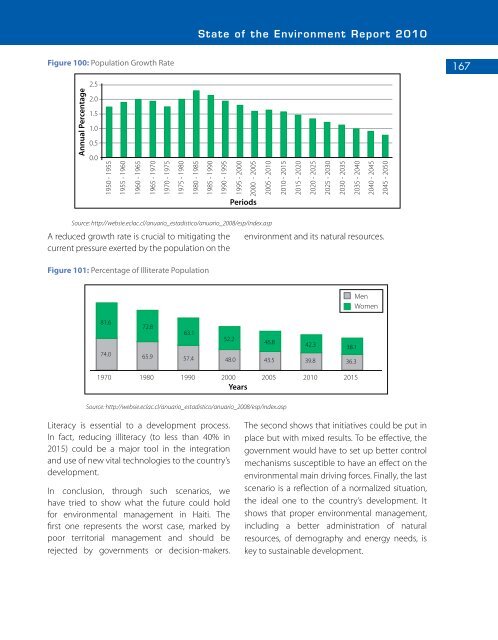GEO Haiti 2010
GEO Haiti 2010
GEO Haiti 2010
You also want an ePaper? Increase the reach of your titles
YUMPU automatically turns print PDFs into web optimized ePapers that Google loves.
State of the Environment Report <strong>2010</strong><br />
Figure 100: Population Growth Rate<br />
167<br />
2.5<br />
Annual Percentage<br />
2.0<br />
1.5<br />
1.0<br />
0.5<br />
0.0<br />
1950 - 1955<br />
1955 - 1960<br />
1960 - 1965<br />
1965 - 1970<br />
1970 - 1975<br />
1975 - 1980<br />
1980 - 1985<br />
1985 - 1990<br />
1990 - 1995<br />
1995 - 2000<br />
2000 - 2005<br />
Periods<br />
2005 - <strong>2010</strong><br />
<strong>2010</strong> - 2015<br />
2015 - 2020<br />
2020 - 2025<br />
2025 - 2030<br />
2030 - 2035<br />
2035 - 2040<br />
2040 - 2045<br />
2045 - 2050<br />
Source: http://websie.eclac.cl/anuario_estadistico/anuario_2008/esp/index.asp<br />
A reduced growth rate is crucial to mitigating the<br />
current pressure exerted by the population on the<br />
Figure 101: Percentage of Illiterate Population<br />
environment and its natural resources.<br />
Men<br />
Women<br />
81.6<br />
72.8<br />
63.1<br />
52.2<br />
46.8 42.3 38.1<br />
74.0 65.9 57.4 48.0 43.5 39.8 36.3<br />
1970 1980 1990 2000 2005 <strong>2010</strong> 2015<br />
Years<br />
Source: http://websie.eclac.cl/anuario_estadistico/anuario_2008/esp/index.asp<br />
Literacy is essential to a development process.<br />
In fact, reducing illiteracy (to less than 40% in<br />
2015) could be a major tool in the integration<br />
and use of new vital technologies to the country’s<br />
development.<br />
In conclusion, through such scenarios, we<br />
have tried to show what the future could hold<br />
for environmental management in <strong>Haiti</strong>. The<br />
first one represents the worst case, marked by<br />
poor territorial management and should be<br />
rejected by governments or decision-makers.<br />
The second shows that initiatives could be put in<br />
place but with mixed results. To be effective, the<br />
government would have to set up better control<br />
mechanisms susceptible to have an effect on the<br />
environmental main driving forces. Finally, the last<br />
scenario is a reflection of a normalized situation,<br />
the ideal one to the country’s development. It<br />
shows that proper environmental management,<br />
including a better administration of natural<br />
resources, of demography and energy needs, is<br />
key to sustainable development.

















